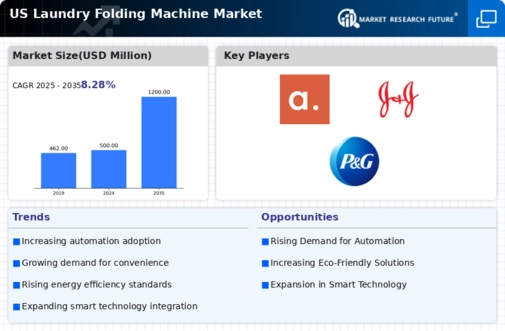Shift Towards Eco-Friendly Products
The laundry folding-machine market is witnessing a shift towards eco-friendly products as consumers become more environmentally conscious. There is a growing demand for appliances that not only perform efficiently but also minimize energy consumption and reduce waste. Recent statistics reveal that approximately 70% of consumers in the US are willing to pay a premium for sustainable products. This trend is prompting manufacturers to invest in research and development to create energy-efficient laundry folding machines that align with eco-friendly practices. As sustainability becomes a priority, the laundry folding-machine market is likely to see increased competition among brands that emphasize their commitment to environmental responsibility.
Growing Awareness of Space Optimization
The market is benefiting from a heightened awareness of space optimization among consumers. With urban living spaces becoming more compact, individuals are increasingly seeking solutions that maximize utility without compromising on aesthetics. Laundry folding machines that are designed to be space-efficient and visually appealing are gaining traction. Recent surveys indicate that around 55% of urban dwellers in the US consider space-saving features as a critical factor when purchasing home appliances. This trend is likely to drive demand for innovative designs in the laundry folding-machine market, as manufacturers strive to create products that cater to this need.
Technological Integration in Smart Homes
The integration of advanced technology in smart homes is reshaping the laundry folding-machine market. As consumers increasingly adopt smart home devices, there is a growing expectation for appliances to connect seamlessly with other technologies. Features such as app control, voice activation, and integration with home automation systems are becoming essential. Market data indicates that nearly 40% of new home buyers in the US prioritize smart home capabilities, which suggests a strong potential for laundry folding machines that offer these functionalities. This trend is likely to encourage manufacturers to innovate and develop products that align with the smart home ecosystem.
Increased Consumer Demand for Convenience
The laundry folding-machine market is experiencing a notable surge in consumer demand for convenience-driven solutions. As lifestyles become increasingly hectic, individuals seek ways to streamline household chores. This trend is particularly pronounced among working professionals and families, who often struggle to find time for mundane tasks. According to recent data, approximately 60% of households in the US express a desire for automated solutions to reduce time spent on laundry. This growing inclination towards convenience is likely to propel the laundry folding-machine market forward, as manufacturers respond by innovating and enhancing product features to meet consumer expectations.
Rising Labor Costs and Workforce Shortages
The laundry folding-machine market is significantly influenced by rising labor costs and workforce shortages in the US. As businesses face challenges in hiring and retaining staff, particularly in the service and hospitality sectors, there is a pressing need for automation to maintain operational efficiency. The cost of labor has increased by approximately 15% over the past five years, prompting many establishments to invest in automated solutions. This shift not only alleviates the burden of manual labor but also enhances productivity, thereby driving growth in the laundry folding-machine market as businesses seek to optimize their operations.














Leave a Comment